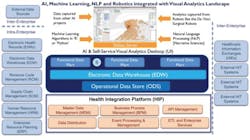Integrating AI with visual analytics to enhance quality of care delivery
For the last three to four decades, healthcare providers have delivered services based on the fee-for-service model. They have treated patients for their ailments, discharged them, and then charged them for the services delivered via Health Insurance Payers as intermediaries, with little accountability for the health and well-being of the patient. Under the tenets of the Affordable Care Act (ACA), many of them are now transforming to an Accountable Care Organizations (ACO), which has triggered a fundamental morphing of the fee-for-service model into a pay-for-performance (P4P) model.
This transformation demands a fundamental evolution of the provider business strategy. Providers will need to deliver the highest quality of healthcare delivery and safety for their patients at the lowest possible cost—while ensuring that they are not re-admitted for the same diseases or disorders that they were treated for in the first place. Inability to ensure this would detract from their P4P metrics such as 30-day re-admission rates and invite fines, and penalties that will negatively impact their reputation, revenues, and profits.
A key factor to enabling this strategic transformation will be leveraging artificial intelligence (AI), machine learning, natural language processing (NLP), and robotics with analytics to increase efficiencies and productivity for repetitive human tasks and processes, while delivering accurate, reliable and right-time actionable insights to executives, physicians, clinicians, and nurses at the point of care (POC).
Specifically, the AI portfolio of technologies likely to be deployed include machine learning algorithms based on ‘R’ and ‘Python’, NLP which will be integrated with the current healthcare IT landscape, the electronic data warehouse (EDW), and next generation self-service visual analytics platforms as shown in Figure 1.
Here’s how the various elements of AI, integrated with visual analytics, will enable specific processes and use cases in a healthcare system:
- Segmenting their attributed patient population based on their vital signs and other publicly available information to understand their risk of chronic conditions like heart disease, diabetes, and cancer—leveraging visual analytics platforms integrated with NLP. This will enable line of business leaders, strategic planning and population health management analysts to see a summary of the analytics in plain text and accelerate their time-to-value.
- Proactively collecting patient data via patient portals into electronic health records (EHRs) is already being done today. Once these patients are admitted for acute conditions like heart failure or heart attacks, running patient risk stratification machine learning algorithms based on Python or ‘R’ combined with visual analytics and NLP would help physicians and administrators proactively identify the most at-risk patients likely to overstay their length-of-stay and at risk of 30-day re-admissions. This will help drive the appropriate clinical care protocols and care coordination to ensure higher quality at a lower risk and cost.
- Personalize the treatment for high-risk patients (1-5% of total) through precision medicine (based on an understanding of their genomic profiles and variances thereof). Machine-learning algorithms using ‘R’ and Python to identify these genetic variances hold tremendous potential, as well as NLP combined with visual analytics, to generate summary reports that is easily consumed by researchers, clinicians, and nurses, and support their efforts to personalize treatment protocols for these high-risk patients, as well as newly born infants whose genomic profiles are captured with those of their patients.
- Leverage robotics for repetitive tasks and processes like sterilization of surgical instruments, as well as the use of robots like the Da Vinci Robot System for faster surgeries, with lower blood loss, and speedier recuperation for patients.
AI holds tremendous yet untapped potential in the healthcare industry, in terms of enhancing decision support, augmenting repetitive processes through automation, and enabling mission critical decisions at the POC. Integrating of these machine learning, NLP, and robotics capabilities with next-generation self-service visual analytics platforms will drive yet unprecedented efficiencies and higher employee productivity in enabling a higher quality of care delivery, with consistency, and at lower total cost of care, in the foreseeable future.




